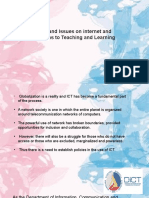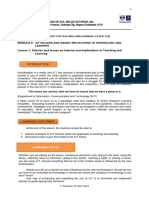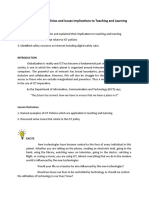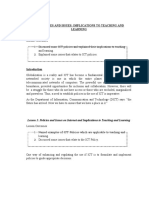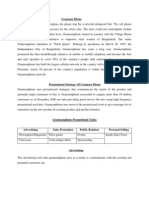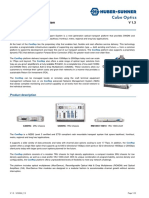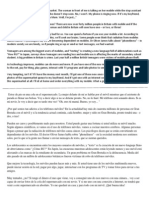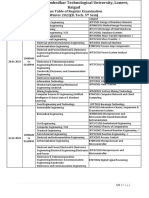0% found this document useful (0 votes)
40 views3 pagesTTL 1 Lesson 4
The document discusses ICT policies and related issues and their implications for teaching and learning. It covers the following key points:
1) The need for ICT policies to guide use of technologies and ensure access and inclusion as networks break down boundaries.
2) ICT policies cover information technology, telecommunications, and networking technologies. The DICT Roadmap in the Philippines supports ICT integration in education.
3) Issues around ICT policies include ensuring access and protecting civil liberties like freedom of expression, privacy, and data security. Regulation of technologies like data retention and surveillance are also discussed.
4) Implications for teaching include guiding appropriate integration of ICT and content about related policies and issues,
Uploaded by
kristine generalCopyright
© © All Rights Reserved
We take content rights seriously. If you suspect this is your content, claim it here.
Available Formats
Download as DOCX, PDF, TXT or read online on Scribd
0% found this document useful (0 votes)
40 views3 pagesTTL 1 Lesson 4
The document discusses ICT policies and related issues and their implications for teaching and learning. It covers the following key points:
1) The need for ICT policies to guide use of technologies and ensure access and inclusion as networks break down boundaries.
2) ICT policies cover information technology, telecommunications, and networking technologies. The DICT Roadmap in the Philippines supports ICT integration in education.
3) Issues around ICT policies include ensuring access and protecting civil liberties like freedom of expression, privacy, and data security. Regulation of technologies like data retention and surveillance are also discussed.
4) Implications for teaching include guiding appropriate integration of ICT and content about related policies and issues,
Uploaded by
kristine generalCopyright
© © All Rights Reserved
We take content rights seriously. If you suspect this is your content, claim it here.
Available Formats
Download as DOCX, PDF, TXT or read online on Scribd
/ 3


















